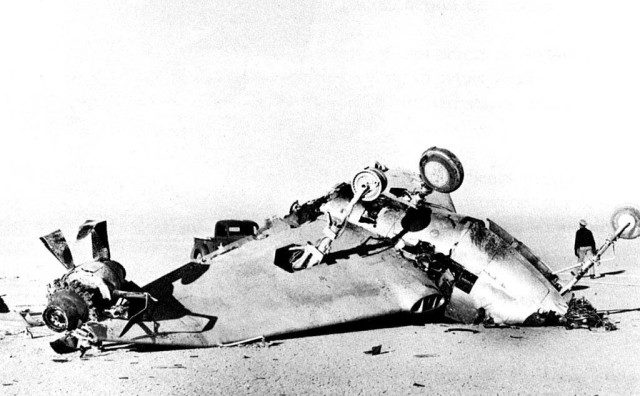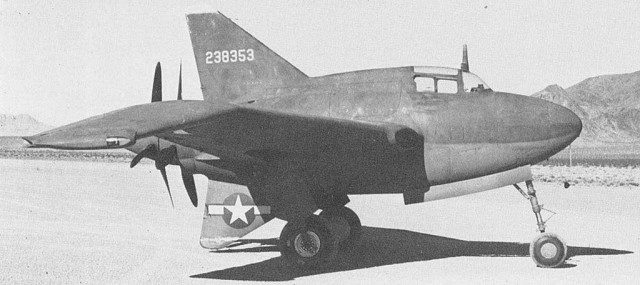Built by the Northrop Corporation, the Northrop XP-56 Black Bullet was a very different prototype fighter interceptor.
This was one of the most radical experimental aircraft built during WWII. In the end, it was not successful and didn’t go into production.
In 1939, the original idea for the XP-56 was quite unique.

There was to be no horizontal tail, only a small vertical one, it used an experimental engine, and they were going to use a different type of metal. The plane was to be a wing with a small centralized fuselage added to house the engine and pilot.
They were hoping that this layout would have less aerodynamic drag than a normal plane.
This idea for a single-seat plane started in 1939 as the Northrop N2B model. They designed it around the Pratt & Whitney liquid-cooled X-1800 engine in a pusher design driving contra-rotating propellers.
The United States Army ordered Northrop to start production on June 22nd, 1940, and after reviewing the design they ordered a prototype plane on September 26th, 1940.
Not too long after the work on the design began, Pratt & Whitney stopped making the X-1800, so the R-2800 was swapped out with the X-1800 even though it was not thought to suitable.
Even though the new engine was more powerful (2,000 horsepower vs 1,800 horsepower) it was larger in diameter and would require a larger fuselage to house the engine.

They expected the new engine would require a 2,000lb weight increase and it would slow the plane down by 14 mph in top speed. Because this tailless design was a novel idea and considered high risk, it was decided to make a small, lightweight plane of a similar design for testing calling it the Model N-1M. Along with the design of the XP-56, successful flight trials of the design were done using this airframe, confirming the basic layout. It used two small Lycoming engines to power the plane.
The trials confirmed the stability of this radical design, and after the review by the United States Army, they decided to order a second prototype on February 13th, 1942.
Northrop used magnesium alloy for the frame and skin of the plane because aluminum was going to be in short supply due to the war.
At the time, there was very little known about using magnesium in aircraft construction.
Since magnesium cannot easily be welded using normal techniques, Northrop hired Vladimir Pavlecka to develop a Heli arc welding techniques for magnesium alloy.
It was later discovered that General Electric had already developed such techniques in the 1920s.
In late March 1943, first engine runs in the plane were tested, but excessive propeller shaft flex caused the engine to fail.
Pratt & Whitney did not send another engine until August, causing them a five-month delay.

On April 6th, 1943, taxi tests of the XP-56 showed a serious yaw problem. In the beginning, they thought it was caused by uneven wheel brakes, and they spent a lot of time trying to fix the brake issue. They installed manual hydraulic brakes, and the plane took flight on September 30th, 1943 at Muroc Air Base in southern California.
The yaw problem was later traced to a lack of aerodynamic stability, and to fix this the ventral stabilizer was enlarged from a mere stub to one almost matching the ventral unit ion shape and area.

After several flights, the first XP-56 was destroyed on October 8th, 1943 during a high-speed taxi across the Muroc Dry Lake, when a tire on the left gear blew out.
John Myers, the pilot, came out of the wreck with only minor injuries, in which he gave credit to wearing a polo player’s helmet.
Myers was the test pilot for many of the different designs during the war.
Several changes were made to the second prototype, which included re-ballasting to move the center-of-gravity forward, enlarging the size of the upper vertical tail, and re-doing the rudder control linkages.
The second prototype was not finished until January 1944.
The plane flew on March 23rd, 1944, even though the pilot had a problem lifting the nose wheel below 160mph.
The pilot also said there was major yaw sensitivity.
The flight lasted less than eight minutes, but later flight lasted much longer, and the nose heaviness vanished when the landing gear was retracted.
Unfortunately, they were only able to able to go low speeds.

While asking for NACA to find out what was causing the issue with getting to desired speeds, they went ahead with other test flights.
During the 10th flight, the pilot discovered extreme tail heaviness, a lack of power, and major fuel consumption.
After that flight, testing ceased because it was too dangerous and the project was abandoned after one year of inactivity.
The United States Army Air Forces were developing jet-powered fighters by 1946 and had no need for a new piston-powered fighter aircraft.
